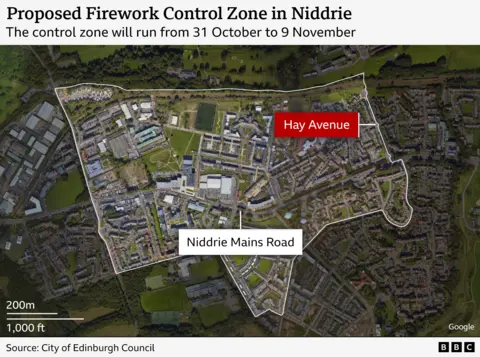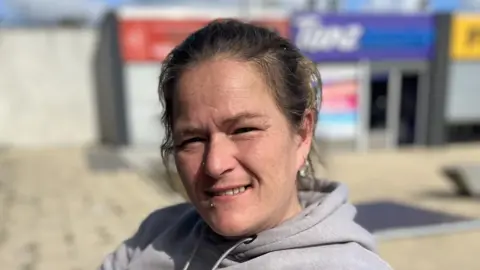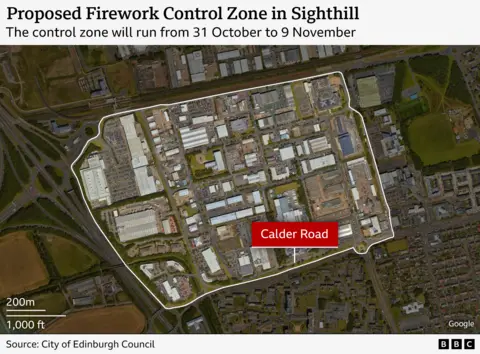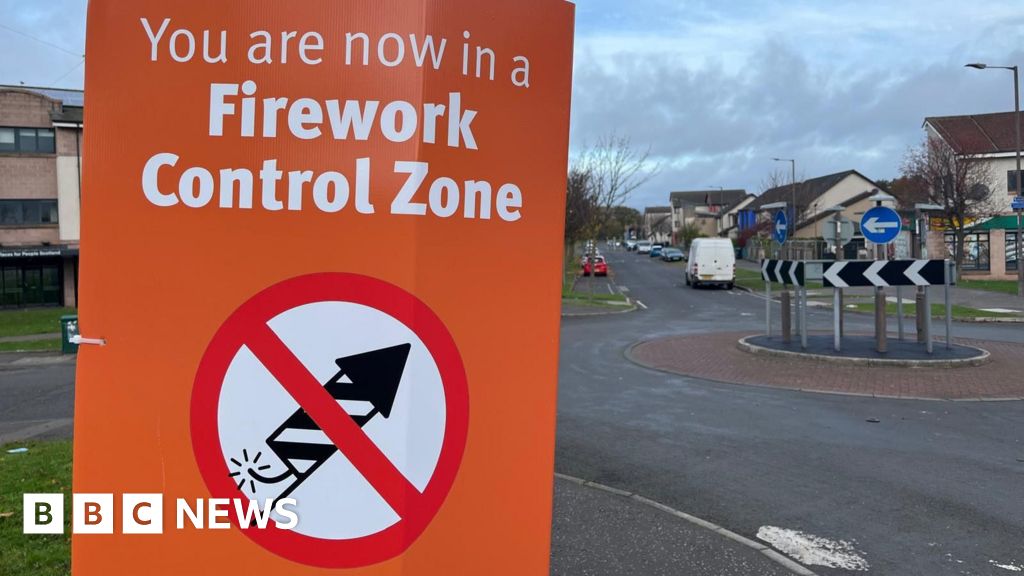Steven Godden and
Aimee Stanton
 PA Media
PA MediaFireworks ban zones in Edinburgh do not fully cover areas that have seen some of the worst bonfire night trouble in recent years, it has emerged.
The official firework control zone (FCZ) boundaries cut some streets in half, with only one side covered by the restrictions.
They include Hay Avenue in Niddrie, where the dividing line runs down the centre of a road where explosives were thrown at riot police during a stand-off two years ago.
The leader of City of Edinburgh Council has admitted that the control zones are “arbitrary” – but says she is confident they will continue to make the streets safer.
Last year Edinburgh became the first Scottish council to introduce a fireworks ban in parts of the city, including Niddrie.

This came the year after clashes between young people and riot police in Hay Avenue.
Video footage of the incident showed fireworks and petrol bombs being thrown at officers.
Riot police were attacked with bricks and fireworks last year, despite the restrictions, and a female police officer was injured when the window of her vehicle was shattered.
Local resident Liz Jack has lived in the area since 2016 and says the firework season is “absolutely terrifying”.
She said the trouble escalated in 2023.
“They were firing rockets up and down the street and they were hitting off the window,” she said.
“I was petrified with all the noise that was going on.”

Last year Ms Jack stayed in a hotel to escape the trouble.
“I sort of resent it [staying in a hotel], it’s a lot of money to do that for one night.
“It upsets my routine. I have a breathing machine I have to use at night, so that has to be packed up and taken with me.”
Neighbours told her that the disorder had not been as bad last year as it was in 2023.
Niddrie, Balerno, Calton Hill and Seafield all had firework restrictions in place in 2024.
This year zones have also been set up in Corstorphine, Moredun, Gracemount, Longstone and Sighthill.
Ms Jack said she had presumed the control zone would cover the whole of Niddrie and not just part of it.
“To me a permanent ban would be better than just the 10 days,” she added.
“They’ll just go somewhere else and start it – they’re determined to cause chaos.”

This year’s restrictions will run from 31 October to 9 November.
During that period it will be a criminal offence to set off a firework in an FCZ, including throwing one into the zone, unless part of an organised and licensed event.
The control zones are expected to run alongside police dispersal zones which can stop groups of two or more people from gathering.
The other roads which are split in half by restrictions include Captain’s Road in Gracemount and Calder Road in Sighthill.
Local resident Nikita Hunter said the restrictions should cover the whole of Captain’s Road – but does not think the control zones will make any difference.
“It’s not going to work. Nothing is going to work, they’re going to do it anyway.
“If the police can’t do anything about it then who can?”
Ms Hunter said last year’s trouble had stopped residents from going in and out of the area. Her dog was also scared by the fireworks.

Jane Meagher, the leader of City of Edinburgh Council, said the fireworks zone had been “successful and effective”in controlling the worst of the disorder in Niddrie last year.
Asked about the boundary which splits Hay Avenue, she replied: “The control zones are in a sense arbitrary.
“But I am confident the exact arrangements that we had last year will bring about the same consequences this year, which is a safer experience for everybody.”
And she added: “This year if we find there are problems in relation to the zones then we definitely would consider changing them.”
Calder Road in Sighthill was also the scene of serious public disorder last year.
Ms Meagher said it was her understanding that fireworks had not been at the centre of the disorder.
“The advice we’re getting is other things, such as dispersal orders, are more appropriate for the kind of disorder that happened in areas like Sighthill,” she said.

However, a recent court case heard that the petrol station on Calder Road was targeted with fireworks, and rockets were also set off near a petrol tanker.
The neighbouring Sighthill Fire Station was also in lockdown due to the unrest, resulting in crews unable to leave or return to the station.
Neither site is covered by the Sighthill’s control zone this year.
Dr Nick McKerrell, senior lecturer in law at Glasgow Caledonian University, said the control zones could be seen as a deterrent.
“In theory it’s a good idea to localise laws as much as possible because communities can get involved,” he said.
“The difficulty is the detail.”
He said that where a law states it is a crime to do something in one area but not in another, it has to be “very specific on the reasons for the limitations.
“That’s why this is a big test.”
Edinburgh is not the only council in Scotland to enforce firework control zones this year.
They will also be introduced in Glasgow following a failed attempt to implement zones in 2024. The areas of Govanhill, Pollokshields and Broomhouse will be covered by restrictions from 1 to 10 November.

